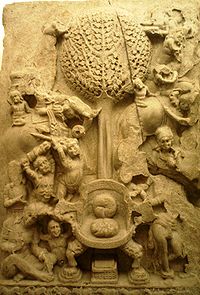.gif)
Mara (demon)
Encyclopedia

Buddhism
Buddhism is a religion and philosophy encompassing a variety of traditions, beliefs and practices, largely based on teachings attributed to Siddhartha Gautama, commonly known as the Buddha . The Buddha lived and taught in the northeastern Indian subcontinent some time between the 6th and 4th...
, Māra is the demon
Demon
call - 1347 531 7769 for more infoIn Ancient Near Eastern religions as well as in the Abrahamic traditions, including ancient and medieval Christian demonology, a demon is considered an "unclean spirit" which may cause demonic possession, to be addressed with an act of exorcism...
that tempted Gautama Buddha
Gautama Buddha
Siddhārtha Gautama was a spiritual teacher from the Indian subcontinent, on whose teachings Buddhism was founded. In most Buddhist traditions, he is regarded as the Supreme Buddha Siddhārtha Gautama (Sanskrit: सिद्धार्थ गौतम; Pali: Siddhattha Gotama) was a spiritual teacher from the Indian...
by trying to seduce him with the vision of beautiful women who, in various legends, are often said to be Mara's daughters. In Buddhist cosmology
Buddhist cosmology
Buddhist cosmology is the description of the shape and evolution of the Universe according to the canonical Buddhist scriptures and commentaries.-Introduction:...
, Mara personifies unwholesome impulses, unskillfulness, the "death" of the spiritual life. He is a tempter, distracting humans from practicing the spiritual life by making the mundane alluring or the negative seem positive.
The early Buddhist
Early Buddhist schools
The early Buddhist schools are those schools into which, according to most scholars, the Buddhist monastic saṅgha initially split, due originally to differences in vinaya, and later also due to doctrinal differences and geographical separation of groups of monks.The original saṅgha split into the...
s, however, rather than seeing Mara as a demonic, virtually all-powerful Lord of Evil
Evil
Evil is the violation of, or intent to violate, some moral code. Evil is usually seen as the dualistic opposite of good. Definitions of evil vary along with analysis of its root motive causes, however general actions commonly considered evil include: conscious and deliberate wrongdoing,...
, regarded him as more of a nuisance. Many episodes concerning his interactions with the Buddha have a decidedly humorous air to them.
In traditional Buddhism four senses of the word "mara" are given.
- Klesa-mara, or Mara as the embodiment of all unskillful emotions.
- Mrtyu-mara, or Mara as death, in the sense of the ceaseless round of birthChildbirthChildbirth is the culmination of a human pregnancy or gestation period with the birth of one or more newborn infants from a woman's uterus...
and deathDeathDeath is the permanent termination of the biological functions that sustain a living organism. Phenomena which commonly bring about death include old age, predation, malnutrition, disease, and accidents or trauma resulting in terminal injury....
. - Skandha-mara, or Mara as metaphorMetaphorA metaphor is a literary figure of speech that uses an image, story or tangible thing to represent a less tangible thing or some intangible quality or idea; e.g., "Her eyes were glistening jewels." Metaphor may also be used for any rhetorical figures of speech that achieve their effects via...
for the entirety of conditioned existence. - Devaputra-mara, or Mara the son of a deva (god), that is, Mara as an objectively existent being rather than as a metaphor.
Early Buddhism acknowledged both a literal and "psychological
Psychology
Psychology is the study of the mind and behavior. Its immediate goal is to understand individuals and groups by both establishing general principles and researching specific cases. For many, the ultimate goal of psychology is to benefit society...
" interpretation of Mara. Mara is described both as an entity having a literal existence, just as the various deities of the Vedic pantheon are shown existing around the Buddha, and also is described as a primarily psychological force - a metaphor for various processes of doubt and temptation that obstruct spiritual practice.
"Buddha defying Mara" is a common pose of Buddha sculptures. The Buddha is shown with his left hand in his lap, palm facing upwards and his right hand on his right knee. The fingers of his right hand touch the earth, to call the earth as his witness for defying Mara and achieving enlightenment. This posture is also referred to as the 'earth-touching' mudra
Mudra
A mudrā is a symbolic or ritual gesture in Hinduism and Buddhism. While some mudrās involve the entire body, most are performed with the hands and fingers...
.
Etymology
The word "Mara" comes from the Proto-Indo-European root *mer meaning to die, and so it is related to the European MaraMare (folklore)
A mare or nightmare is a spirit or goblin in Germanic folklore which rides on people's chests while they sleep, bringing on bad dreams . The mare is attested as early as in the Norse Ynglinga saga from the 13th century, but the belief itself is likely to be considerably older...
, the Slavic Marzanna
Marzanna
Maržanna, Mara, Maržena, Morana, Moréna, Mora, Marmora or Morena is a Slavic goddess associated with death, winter and nightmares. Some sources equate her with the Latvian goddess Māra, who takes a person's body after their death...
and the Latvian Māra
Mara
-Social groups:*Mara people, in northeastern India and western Myanmar* Mara language, a language spoken by Mara people*Mara Salvatrucha, a violent criminal gang in Mexico, Central America, Canada, and the United States...
.Mara in Latvian mythology means - The Mother of Earth and has positive meaning. She is wise and generous.
Sources
- Bodhi, BhikkhuBhikkhu BodhiBhikkhu Bodhi , born Jeffrey Block, is an American Theravada Buddhist monk, ordained in Sri Lanka and currently teaching in the New York/New Jersey area...
(trans.) (2000). The Connected Discourses of the Buddha: A Translation of the Samyutta Nikaya. Boston: Wisdom Pubs. ISBN 0-86171-331-1. - Saddhatissa, H. (translator) (1998). The Sutta-Nipāta. London: RoutledgeCurzon Press. ISBN 0-7007-0181-8.

